N. Extraterrestrial Impact Structures
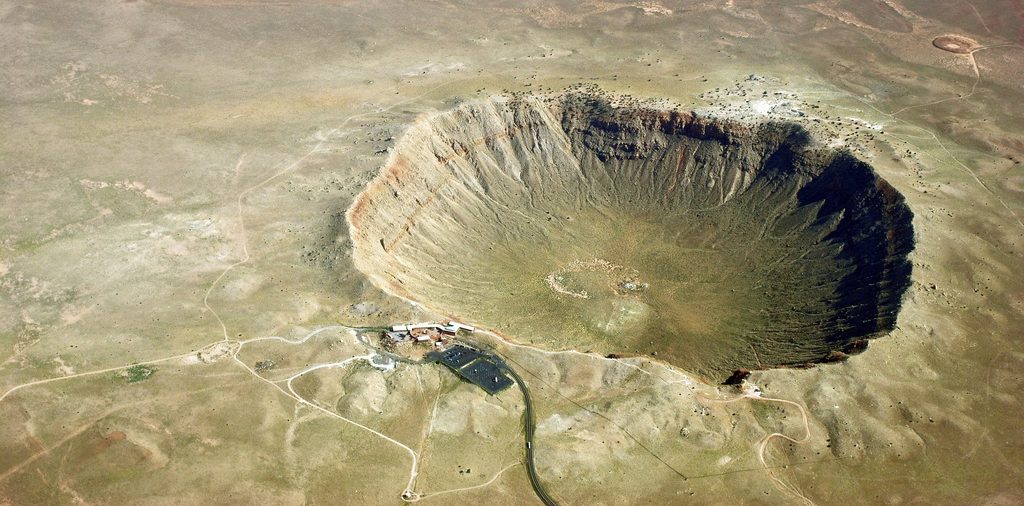
Occurrence of impacts
Extra-terrestrial objects impact the Earth sporadically. There is an inverse relationship between size of object and recurrence interval, although the exact numbers vary depending on whether one considers objects entering the atmosphere or only those that make it to the surface.
Recurrence intervals for extra-terrestrial impacts of various sizes:
- 10 m diameter: approx. 1 yr
- 50 m diameter: approx. 1000 yr
- 1 km diameter: approx. 500,000 yr
- 5 km diameter: approx. every 10 M yr
- 10 km diameter: 65 Ma event was probably most recent
The object that exploded in the atmosphere over Russia in February 2013 is estimated to have been ~17 m in diameter.
Objects approaching the Earth may vary in speed between about 11 km s‑1 and 72 km s‑1, though smaller objects are slowed by drag from the atmosphere.
Meteorite impacts produce some of the highest strain rates on Earth. Typical values of strain rate in the first few microseconds of an impact may be of the order of 108 s‑1. (Contrast the strain rates during an earthquake, typically 0.1 to 10 s-1. By comparison, time-averaged strain rates in orogens due to plate movement are typically 10‑15 to 10‑12 per second.)
One of the most obvious results of an impact is a roughly circular depression called a crater. Major craters have been described from many parts of the Earth. The three largest confirmed examples are:
- Vredefort Crater in South Africa, diameter ~300 km, formed at 2020 Ma, and now deeply eroded;
- Sudbury Basin, 250 km diameter, formed at 1849 Ma and subsequently deformed;
- Chixulub crater, 180 km diameter, 65 Ma.
Impact craters
Larger impacts form craters, which have two types of geometry (Fig. 1).

Simple craters
Simple craters are up to about 4.5 km in diameter. They tend to have simple bowl shapes with a raised rim. (On the moon, where gravity is less, simple craters are up to 15 km diameter.)
Complex craters
Larger craters show complex geometry. The most distinctive feature of complex craters is a central uplift. The inside of the rim of a complex crater typically shows a series of internal terraces, and the outside of the rim may also have concentric ridges and valleys. Between the central uplift and the terraces, the floor of a complex crater is often somewhat flat. These differences may be explained by considering the processes of crater formation, and particularly the “modification stage” (see below).
Impact processes
Contact and compression
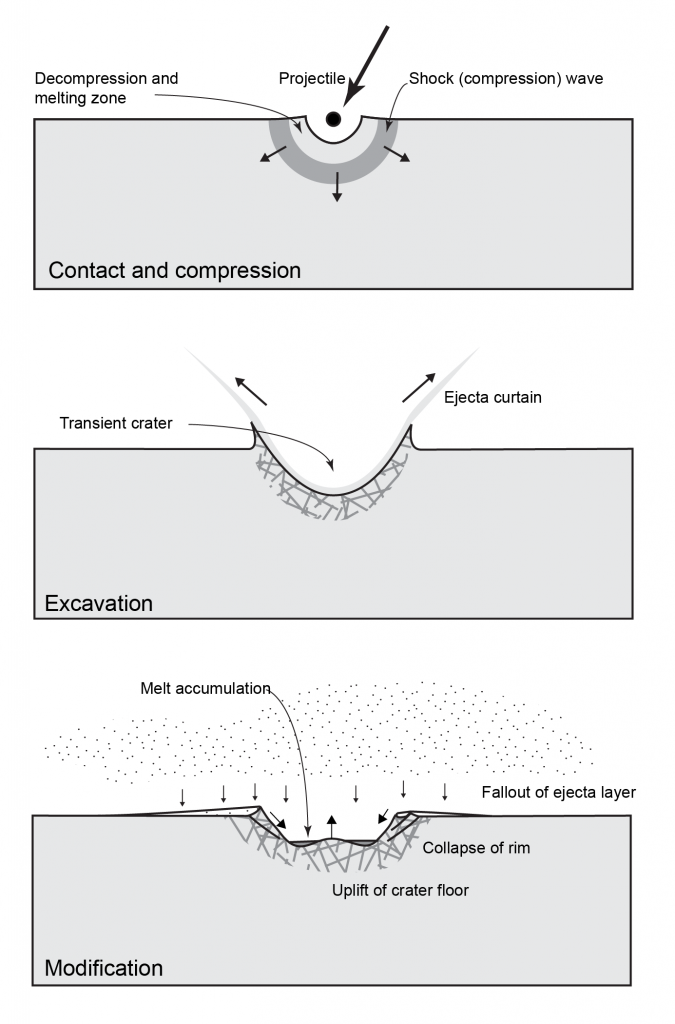
The first stage in the development of an impact crater is the contact and compression stage, beginning when the object first touches the surface. In this stage, the impacting object and the underlying rock are subject to extremely high strain rates of 108 per second or higher. These strain rates may produce enormous stresses above 1 TPa (1012 Pa), and very high temperatures, sufficient to melt or even vaporize large parts of the impacting body and the rocks in front of it. Rock that remains solid is compressed in a shock wave that initially propagates at a speed comparable to that of the incoming body, typically much faster than normal seismic waves.
As the shock wave passes, rock is highly compressed, which depresses the Earth’s surface, starting the process of crater formation. Behind the compressional shock wave, there is a wave of expansion, where the release of elastic energy produces very high temperatures, that melt or vaporize the expanding rock material.
Contact and compression lasts only a few tenths of a second even for a very large impact.
Eventually the speed of the advancing shockwave slows down to seismic velocities (3-7 km s‑1) and continues to propagate through the Earth as a seismic wave, during the next stage.
Excavation stage
Initially the compressional wave moves rock downward and outward but as the wave expands material is pushed upwards at the edges of the expanding crater, creating a raised rim. In addition, as the decompression wave passes, material that was formerly compressed downwards expands upward, and its momentum causes it to be thrown up into the atmosphere. These processes result in the excavation of material (ejecta), into the air and onto the surrounding surface. The resulting depression is known as the transient crater.
The maximum size of the transient crater marks the end of the excavation phase. The excavation stage lasts several minutes in a large crater.
Modification stage
The end of the excavation is followed by crater modification. For small craters the modification process is relatively simple. The floor of the deep transient crater rebounds as the rock decompresses, to produce a shallower, bowl-shaped depression.
In larger impacts, the process is more complex. Rebound of material that has been compressed vertically downward is more complete and produces a central uplift. Surrounding it is a region where rebound takes material upwards and outwards, contributing to the rim. In addition, the rims of these larger craters tend to be unstable, and during the modification stage, large normal faults form, allowing pieces of the rim to subside as terraces.
Ejecta tend to fall back into the crater, and material may remain molten for long enough to pond on the crater floor. Large complex craters tend to have flat floors between the central uplift and the terraced rim.
Rock products of impact
There are a number of products of impacts that can be recognized in the ancient record.
Shatter cones
Shatter cones are conical joint surfaces that are typically decorated with plumose markings. Poles to the surfaces of the cones typically fall on small circles when plotted on a stereographic projection. The axes of the cones point toward the point of impact and can help to locate this point if their orientations are carefully measured.
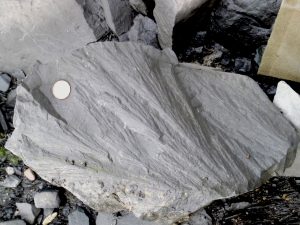
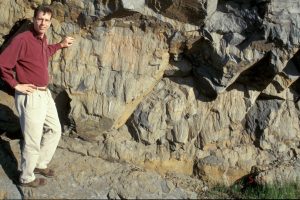
Impact breccia and suevite
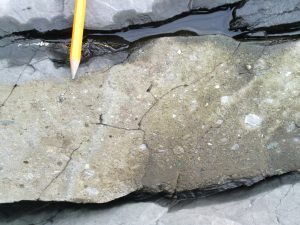
In areas of greater compression, and therefore greater subsequent expansion, impact breccia is produced. Impact breccia may have open spaces between the fragments (which may be filled by later vein minerals if hydrothermal fluids flow through), or the spaces may be filled by melt or by a matrix of small fragments. A fine-grained rock with a breccia texture, consisting of a mixture of rock fragments, glass, and melt, is known as suevite.
Impact melt: pseudotachylite
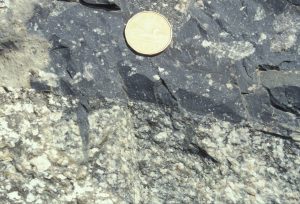
Substantial melting may occur behind the initial shockwave, producing pseudotachylite, similar to the pseudotachylites produced by frictional melting along certain faults. However, much larger volumes of pseudotachylite may be found in impact structures than are common along faults.
Pseudotachylites have a much wider range of compositions than those of normal igneous rocks, because they are produced by more or less complete melting of their parent rocks, rather than the progressive and partial melting in most igneous processes.
In the Sudbury structure a thick layer of impact melt underwent fractional crystallization to yield a thick ore body of massive sulphide.
New minerals
The very high pressures encountered in the contact and compression stage may cause new, high pressure minerals to form. The most notable are two high-pressure polymorphs of silica SiO2. Coesite is a monoclinic form of silica in which the silica tetrahedra are linked in a manner similar to feldspars. It requires pressures above 2 GPa to form. Stishovite is a very dense phase in which the silicon is in octahedral coordination, surrounded by six oxygen atoms in a tetragonal structure. Stishovite requires pressures above 8 GPa.
Diaplectic glass
Mineral grains that are subject to extreme and rapid compression may lose their mineral structure, as bonds between the atoms are broken. On decompression, depending on the temperature, the atoms may be unable to diffuse back into a crystal lattice, with the result that they appear isotropic in thin section, like volcanic glass. However, unlike true pseudotachylite, this glassy material may still display the outlines and compositions of the original crystals, showing that it was never truly molten. This material is known as diaplectic glass.
Breccia resulting from a meteorite striking the Earth.
A fine-grained rock with a breccia texture, consisting of a mixture of rock fragments, glass, and melt, produced during impacts of extra-terrestrial objects.
Material melted by heating during fault movement. Is typically dark and very fine grained or glassy.
A monoclinic form of silica in which the silica tetrahedra are linked in a manner similar to feldspars. It requires pressures above 2 GPa to form.
A high pressure tetragonal polymorph of quartz, in which silicon is in octahedral coordination, surrounded by six oxygen atoms.
Glass generated by the action of a shockwave on common minerals.

